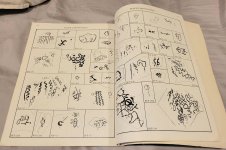magua
Full Member
- Sep 18, 2022
- 109
- 313
I’m currently looking for anyone that is good with petroglyphs and rock art. If somebody has a education or training, specifically in that, that would be great or if somebody has a great deal of experience in working with others on those type of projects, that would be great as well. I’m presently working with a group and We’re trying to track down some further details about a petroglyph that we have documented. It’s similar to others, but has additional details on it and we’re trying to get some additional ideas, confirm, some thoughts, or rule out some ideas that we already have. You can direct message me. I’d be happy to share the information and review some of the details.
I’d share some of the material publicly on the list, but a great deal of it has yet to be published, and there is an area directly adjacent to this new find that has been declared a heritage site, but has received a great deal of vandalism or looking at a potential future project, or dig site with the new find, we are trying to prevent any damage or vandalism to this area.
This would be related to petroglyphs that are common in the Ohio valley areas of Pennsylvania, some areas of West Virginia, and Ohio, of course.
We have multiple messages out to various individuals that are rock art specialist in various universities and museums across the US. We’re gathering information from those sources. it’s time for me to dip into rock art specialist that may have tons of experience and can offer any evidence or details on the subject from their experiences or prior education.
Pennsylvania has a very unique system when it comes to archaeology that has been sort of passed on from years gone by. We have professional archaeologist where you have official education and degrees, etc. We also have professional archaeologists who have been doing it for 30 to 50 years For several of them but they may not have specific degrees that apply directly to that area in education, but their overwhelming knowledge is priceless. And then we have archaeologist enthusiasts/amateurs who may have a great deal of knowledge, be very active in providing assistance, and learning and eventually, after many years, they may also be considered at a professional level due to their learning and experience from the veterans.
If you have a lot of knowledge and experience with these things, step forward, and I can tap your mind and enlighten you with maybe something you’ve never seen before as well.
There was one gentleman on here who had a very thorough experience and knowledge but, he seems to have gone silent, and I can no longer locate his info. I know I had it in my personal email as well but I had lost one of my email accounts and screwed that up, so I don’t have access to that info.
Thank you in advance
I’d share some of the material publicly on the list, but a great deal of it has yet to be published, and there is an area directly adjacent to this new find that has been declared a heritage site, but has received a great deal of vandalism or looking at a potential future project, or dig site with the new find, we are trying to prevent any damage or vandalism to this area.
This would be related to petroglyphs that are common in the Ohio valley areas of Pennsylvania, some areas of West Virginia, and Ohio, of course.
We have multiple messages out to various individuals that are rock art specialist in various universities and museums across the US. We’re gathering information from those sources. it’s time for me to dip into rock art specialist that may have tons of experience and can offer any evidence or details on the subject from their experiences or prior education.
Pennsylvania has a very unique system when it comes to archaeology that has been sort of passed on from years gone by. We have professional archaeologist where you have official education and degrees, etc. We also have professional archaeologists who have been doing it for 30 to 50 years For several of them but they may not have specific degrees that apply directly to that area in education, but their overwhelming knowledge is priceless. And then we have archaeologist enthusiasts/amateurs who may have a great deal of knowledge, be very active in providing assistance, and learning and eventually, after many years, they may also be considered at a professional level due to their learning and experience from the veterans.
If you have a lot of knowledge and experience with these things, step forward, and I can tap your mind and enlighten you with maybe something you’ve never seen before as well.
There was one gentleman on here who had a very thorough experience and knowledge but, he seems to have gone silent, and I can no longer locate his info. I know I had it in my personal email as well but I had lost one of my email accounts and screwed that up, so I don’t have access to that info.
Thank you in advance
Upvote
2













